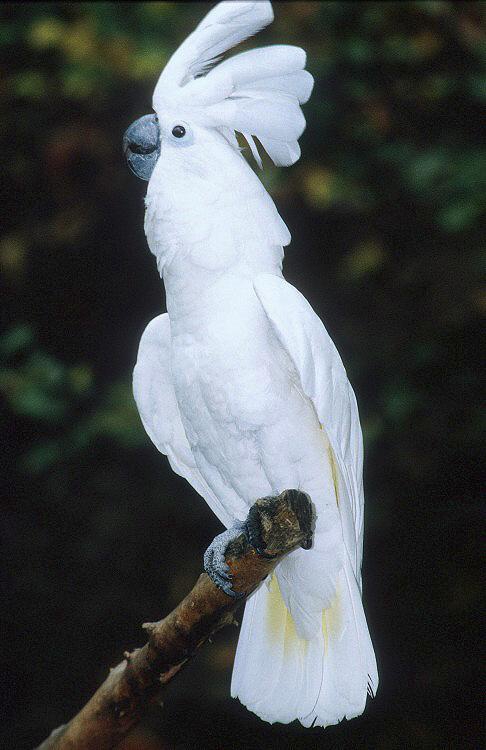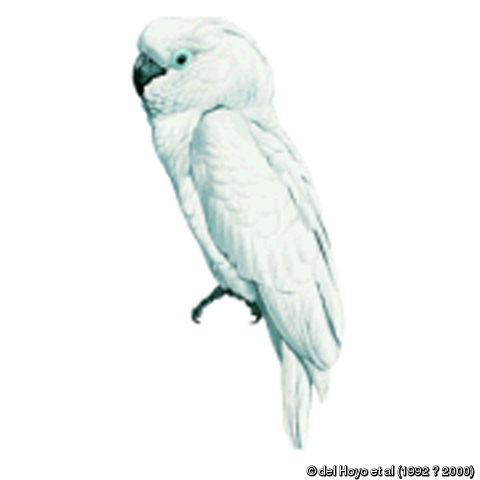| Citation |
|
Description |
Geographic Range [top]
Range Description: Cacatua alba is endemic to the islands of Halmahera, Bacan, Ternate, Tidore, Kasiruta and Mandiole in North Maluku, Indonesia. Records from Obi and Bisa are thought to reflect introductions, and an introduced population breeds locally in Taiwan (China). It remains locally common: in 1991-1992, the population was estimated at 42,545-183,129 birds (Lambert 1993), although this may be an underestimate as it was largely based on surveys from Bacan and not Halmahera where the species may have been commoner. Recent observations indicate that rapid declines are on-going, and are predicted to increase in the future (Vetter 2009). CITES data show significant harvest rates for the cage bird trade during the early 1990s, extending at least to the end of that decade (ProFauna, S. Metz in litt. 2016). Annual harvests have declined in actual terms and as a proportion of the remaining population in recent years, but illegal trade continues and is likely to have been underestimated (S. Metz in litt. 2013).
Countries occurrence:
Native:
Indonesia
Additional data:
? Continuing decline in area of occupancy (AOO): Unknown
? Extreme fluctuations in area of occupancy (AOO): No ? Estimated extent of occurrence (EOO) - km2: 51700
? Continuing decline in extent of occurrence (EOO): Unknown ? Extreme fluctuations in extent of occurrence (EOO): No
? Number of Locations: 11-100 ? Continuing decline in number of locations: Unknown
? Extreme fluctuations in the number of locations: No
? Upper elevation limit (metres): 900
Range Map: Click here to open the map viewer and explore range.
Population [top]
Population: The global population has been estimated to number c.43,000-183,000 individuals (Lambert 1993).
Trend Justification: Vetter (2009) used remote sensing techniques to track the rate and spatial pattern of forest loss in the North Maluku Endemic Bird Area between 1990 and 2003, and projected rates of deforestation over the next three generations for the regions restricted range birds. This study estimated the rate of forest loss within the geographic and elevation range of C. alba to be c.20.2% between 1990 and 2003, and projected the loss of c.65.4% of forest in its range over the next three generations. CITES data indicate that at its peak in 1991, the legal international cage-bird trade was taking c.17% of the global population annually. It is likely there is additional unrecorded and unregulated illegal and national trade in this species, so the population is inferred to be declining at a rapid rate, and is predicted to become very rapid over the next three generations (39 years).
Current Population Trend: Decreasing
Additional data:
? Continuing decline of mature individuals: Yes
? Extreme fluctuations: No ? Population severely fragmented: No
? No. of subpopulations: 2-100 ? Continuing decline in subpopulations: Unknown
? Extreme fluctuations in subpopulations: No ? All individuals in one subpopulation: No
Habitat and Ecology [top]
Habitat and Ecology: It is resident (perhaps making minor nomadic movements) in primary, logged and secondary forest up to 900 m. It also occurs in mangroves, plantations (including coconut) and agricultural land, suggesting that it tolerates some habitat modification. The highest densities occur in primary forest, and it requires large trees for nesting and communal roosting.
Systems: Terrestrial
Continuing decline in area, extent and/or quality of habitat: Yes
Generation Length (years): 13
Movement patterns: Not a Migrant
Threats [top]
Major Threat(s): Unsustainable levels of trapping for the cage-bird trade pose the greatest threat. In 1991, an estimated minimum of 6,600 birds (possibly representing a mere quarter of the actual figure) were taken from the wild. Catch quotas for the species were exceeded by up to 18 times in some localities, indicating that trappers were removing in the order of 17% of the population annually. In 2007, the catch quota was 10 pairs, and only for breeding purposes. However, an investigation by ProFauna revealed that at least 200 White Cockatoo were caught from the wild in North Halmahera in 2007, far exceeding the quota (ProFauna in litt. 2008). Illegal trade continues and is probably grossly underestimated, with many birds being smuggled through Sulawesi and ending up in the bird markets of western Indonesia or being transported to the Philippines (S. Metz in litt. 2013). Although forest within parts of its range remains relatively intact, exploitation by logging companies has become intensive, and some areas are have been cleared for agriculture and mining. Vetter (2009) estimated that forest loss within the geographic and elevation range of C. alba was c.20.2% between 1990 and 2003, and projected the loss of c.65.4% of forest in its range over the next three generations. Significant changes in forest cover on Halmahera appear to have driven a concomitant decline in the cockatoo population (F. Lambert in litt. 2012). Habitat and nest-site availability is therefore decreasing, particularly the latter. Furthermore, new logging roads greatly facilitate access for trappers.
Conservation Actions [top]
Conservation Actions: Conservation Actions Underway
CITES Appendix II. The North Maluku government has proposed to the Forestry Ministry that the species be classified as a protected species (C. Trainor in litt. 2005). The Indonesian government issues catch quotas and all capture was illegal in 1999. It occurs in two protected areas: Gunung Sibela Strict Nature Reserve on Bacan (although this site is threatened by agricultural encroachment and gold prospecting) and the 167,300 ha Aketajawe-Lolobata National Park on Halmahera, which was declared protected in 2004. A project was set up by Burung (BirdLife) Indonesia in 2007 to set up effective protected area management in the Aketajawe-Lolobata National Park, including monitoring wildlife trade, raising public awareness and support, and providing training for Aketajawe-Lolobata National Park staff and related partners (Waugh 2009). The species is fairly common in captivity (Lambert 1993).
Conservation Actions Proposed
Monitor national and international trade. Conduct research into population dynamics, ranging behaviour and threats, so that appropriate trapping quotas may be devised. Promote more effective enforcement of trapping quotas. Improve patrolling of the routes used for wildlife smuggling from Indonesia, especially to off-shore sites of the Philippines (where cockatoos and parrots are often unloaded) and northern Sulawesi. Introduce trapping concessions to increase self-regulation of trade and the regulated collection of eggs and young, rather than adults. Initiate a conservation awareness campaign directed at adults and schoolchildren promoting local pride and support for the species (D. Nandika and D. Agustina per S. Metz in litt. 2016). Development of captive breeding programmes has been suggested.
Citation: BirdLife International. 2018. Cacatua alba. The IUCN Red List of Threatened Species 2018: e.T22684789A131915204. http://dx.doi.org/10.2305/IUCN.UK.2018-2.RLTS.T22684789A131915204.en. Downloaded on 19 February 2019.
Disclaimer: To make use of this information, please check the .
Feedback: If you see any errors or have any questions or suggestions on what is shown on this page, please provide us with feedback so that we can correct or extend the information provided
|


